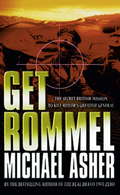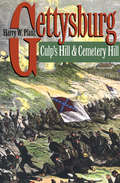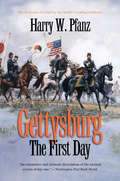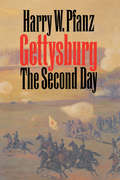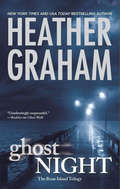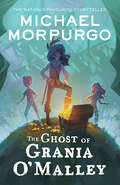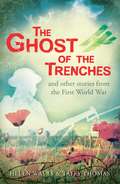- Table View
- List View
Germany’s French Allies 1941–45 (Men-at-Arms #556)
by Massimiliano AfieroA fully illustrated study of the Wehrmacht's French volunteer units and their actions on the Eastern Front and in North Africa during World War II.It is little known that, in late 1941, French volunteer units were among Wehrmacht troops defending Germany in the first bitter winter on the Eastern Front, and also among the last fighting for Berlin in April 1945. After Germany invaded the Soviet Union in June 1941, some 13,000 Frenchmen enlisted in the 'Légion des volontaires français contre le bolchévisme' (LVF), which was reformed as the Wehrmacht's Infanterie-Regiment 638 and posted to Russia.This volume examines the involvement of French volunteers, not only on the Eastern Front, but also in the 'Phalange Africaine' in Tunisia and in the 'Légion Tricolore', a short-lived military organization under the control of the French Vichy government. Using archive photographs and specially commissioned artwork, it casts a new light on forces fighting for the Axis and studies the French personnel's equipment, insignia and uniforms while describing their involvement in some of the most gruelling battles of World War II.
Germany’s French Allies 1941–45 (Men-at-Arms #556)
by Massimiliano AfieroA fully illustrated study of the Wehrmacht's French volunteer units and their actions on the Eastern Front and in North Africa during World War II.It is little known that, in late 1941, French volunteer units were among Wehrmacht troops defending Germany in the first bitter winter on the Eastern Front, and also among the last fighting for Berlin in April 1945. After Germany invaded the Soviet Union in June 1941, some 13,000 Frenchmen enlisted in the 'Légion des volontaires français contre le bolchévisme' (LVF), which was reformed as the Wehrmacht's Infanterie-Regiment 638 and posted to Russia.This volume examines the involvement of French volunteers, not only on the Eastern Front, but also in the 'Phalange Africaine' in Tunisia and in the 'Légion Tricolore', a short-lived military organization under the control of the French Vichy government. Using archive photographs and specially commissioned artwork, it casts a new light on forces fighting for the Axis and studies the French personnel's equipment, insignia and uniforms while describing their involvement in some of the most gruelling battles of World War II.
Germany's War and the Holocaust: Disputed Histories
by Omer Bartov"While attempts to come to terms with past catastrophe... can help prevent its recurrence, they may also provide arguments for... actions against the real or imagined perpetrators of previous disasters. The confrontation with... catastrophe can help us understand the roots and nature of this century's destructive urges, as well as humanity's extraordinary recuperative capacities; but it can also legitimize the perpetuation of violence and aggression."—from the IntroductionOmer Bartov, a leading scholar of the Wehrmacht and the Holocaust, provides a critical analysis of various recent ways to understand the genocidal policies of the Nazi regime and the reconstruction of German and Jewish identities in the wake of World War II. Germany's War and the Holocaust both deepens our understanding of a crucial period in history and serves as an invaluable introduction to the vast body of literature in the field of Holocaust studies.Drawing on his background as a military historian to probe the nature of German warfare, Bartov considers the postwar myth of army resistance to Hitler and investigates the image of Blitzkrieg as a means to glorify war, debilitate the enemy, and hide the realities of mass destruction. The author also addresses several new analyses of the roots and nature of Nazi extermination policies, including revisionist views of the concentration camps. Finally, Bartov examines some paradigmatic interpretations of the Nazi period and its aftermath: the changing American, European, and Israeli discourses on the Holocaust; Victor Klemperer's view of Nazi Germany from within; and Germany's perception of its own victimhood.
The Geronimo Campaign
by Odie B. FaulkThe surrender of the great Apache leader Geronimo to U.S Army Lieutenant Charles B. Gatewood in August of 1886 brought to an end a struggle that had begun in the early years of the century, and had figured prominently in the western campaign of the Civil War. The words addressed by Gatewood to Geronimo as they met along the banks of Mexico's Bavispe River echoed those spoken in many such a meeting between victorious American commander and vanquished Native American. "Accept these terms or fight it out to the bitter end," said Gatewood. The terms were forced relocation to Florida and the ceding of the ancestral homeland of the Apaches to white settlers; the bitter end was, quite simply, annihilation. In The Geronimo Campaign, Odie B. Faulk, a leading historian of the American Southwest, offers a lively and often chilling account of the war that raged over the deserts and mountains of Arizona, New Mexico, and northern Mexico in the mid 1880's, and traces its legacy well past the ultimatum delivered to Geronimo on August 25, 1886. Faulk is especially concerned with the campaign's wider historical setting and significance, and with the sad record of betrayal of the Native American by the U.S. Government. In a very real sense, it is the stuff of Greek tragedy. Here among the mesas of the Southwest was inevitable conflict and inevitable defeat, with both sides losing and yet surviving their loss. The Apaches were forced to endure years of captivity and humiliation, and--like the Sioux, Comanche, and Nez Percé before them--the obliteration of their traditional way of life. The Army, seemingly the winner, was torn by conflicting claims of glory by its hubristic leaders. And Americans lost much that Apache culture might have contributed to their country, as well as more than a measure of American self-respect. Few emerge from Faulk's riveting account with their dignity and stature intact: only the titanic figure of Geronimo, and to a lesser extent the two men he knew and trusted among his opponents, Gatewood and General George Crook, retain a semblance of honor. Faulk shows that neither side wanted war, that both sides believed in the righteousness of their cause, and that the real instigators of the conflict were rapacious American settlers--the "Tucson Ring" of merchants--who sold grain, hay, and other provisions to the troops as well as to those living on the Indian reservations. Faulk's realistic and colorful narrative highlights many of the campaign's ironies as well as its dangers and vicissitudes. In addition, it vividly recreates life in an Army command post on the western frontier, offers an exceptionally clear and sympathetic life history of Geronimo, and sheds new light on the conflict through many hitherto unknown documents originally collected by Gatewood's son. Also included is a brief history of the Apache people, a full bibliography and notes, and many vintage photographs which lend a rare immediacy to this tragic story. The Geronimo Campaign ends with the great chief hundreds of miles away from his ancestral home, Crook relieved of his command, and Gatewood largely forgotten in the honors and awards bestowed by the Army in recognition of Geronimo's capitulation. A true American saga, this is a book for anyone who wishes to understand the roots of, and the reasons for, the tragic Indian Wars of the nineteenth century, a tragedy whose repercussions are still felt today.
The Geronimo Campaign
by Odie B. FaulkThe surrender of the great Apache leader Geronimo to U.S Army Lieutenant Charles B. Gatewood in August of 1886 brought to an end a struggle that had begun in the early years of the century, and had figured prominently in the western campaign of the Civil War. The words addressed by Gatewood to Geronimo as they met along the banks of Mexico's Bavispe River echoed those spoken in many such a meeting between victorious American commander and vanquished Native American. "Accept these terms or fight it out to the bitter end," said Gatewood. The terms were forced relocation to Florida and the ceding of the ancestral homeland of the Apaches to white settlers; the bitter end was, quite simply, annihilation. In The Geronimo Campaign, Odie B. Faulk, a leading historian of the American Southwest, offers a lively and often chilling account of the war that raged over the deserts and mountains of Arizona, New Mexico, and northern Mexico in the mid 1880's, and traces its legacy well past the ultimatum delivered to Geronimo on August 25, 1886. Faulk is especially concerned with the campaign's wider historical setting and significance, and with the sad record of betrayal of the Native American by the U.S. Government. In a very real sense, it is the stuff of Greek tragedy. Here among the mesas of the Southwest was inevitable conflict and inevitable defeat, with both sides losing and yet surviving their loss. The Apaches were forced to endure years of captivity and humiliation, and--like the Sioux, Comanche, and Nez Percé before them--the obliteration of their traditional way of life. The Army, seemingly the winner, was torn by conflicting claims of glory by its hubristic leaders. And Americans lost much that Apache culture might have contributed to their country, as well as more than a measure of American self-respect. Few emerge from Faulk's riveting account with their dignity and stature intact: only the titanic figure of Geronimo, and to a lesser extent the two men he knew and trusted among his opponents, Gatewood and General George Crook, retain a semblance of honor. Faulk shows that neither side wanted war, that both sides believed in the righteousness of their cause, and that the real instigators of the conflict were rapacious American settlers--the "Tucson Ring" of merchants--who sold grain, hay, and other provisions to the troops as well as to those living on the Indian reservations. Faulk's realistic and colorful narrative highlights many of the campaign's ironies as well as its dangers and vicissitudes. In addition, it vividly recreates life in an Army command post on the western frontier, offers an exceptionally clear and sympathetic life history of Geronimo, and sheds new light on the conflict through many hitherto unknown documents originally collected by Gatewood's son. Also included is a brief history of the Apache people, a full bibliography and notes, and many vintage photographs which lend a rare immediacy to this tragic story. The Geronimo Campaign ends with the great chief hundreds of miles away from his ancestral home, Crook relieved of his command, and Gatewood largely forgotten in the honors and awards bestowed by the Army in recognition of Geronimo's capitulation. A true American saga, this is a book for anyone who wishes to understand the roots of, and the reasons for, the tragic Indian Wars of the nineteenth century, a tragedy whose repercussions are still felt today.
Gestapo: Instrument Of Tyranny
by Edward CrankshawThe Grim story of the most vicious Terror Agency of all time-Its sinister Power and Barbaric acts, and the twisted men who led it-Hitler, Himmler, and Eichmann.This is the brutal expose of the rotten core of Nazi Germany.Here is revealed the true story of Hitler's terror police, the in-famous Gestapo-the madmen who headed it, the sadists who staffed it, the degenerate party that spawned it.
The Gestapo: The Myth and Reality of Hitler's Secret Police
by Frank McDonoughName as a 2016 Book of the Year by the SpectatorA Daily Telegraph 'Book of the Week' (August 2015)Longlisted for 2016 PEN Hessell-Tiltman PrizeRanked in 100 Best Books of 2015 in the Daily TelegraphProfessor Frank McDonough is one of the leading scholars and most popular writers on the history of Nazi Germany. Frank McDonough's work has been described as, 'modern history writing at its very best...Ground-breaking, fascinating, occasionally deeply revisionist' by renowned historian Andrew Roberts. Drawing on a detailed examination of previously unpublished Gestapo case files this book relates the fascinating, vivid and disturbing accounts of a cross-section of ordinary and extraordinary people who opposed the Nazi regime. It also tells the equally disturbing stories of their friends, neighbours, colleagues and even relatives who were often drawn into the Gestapo's web of intrigue. The book reveals, too, the cold-blooded and efficient methods of the Gestapo officers. This book will also show that the Gestapo lacked the manpower and resources to spy on everyone as it was reliant on tip offs from the general public. Yet this did not mean the Gestapo was a weak or inefficient instrument of Nazi terror. On the contrary, it ruthlessly and efficiently targeted its officers against clearly defined political and racial 'enemies of the people'. The Gestapo will provide a chilling new doorway into the everyday life of the Third Reich and give powerful testimony from the victims of Nazi terror and poignant life stories of those who opposed Hitler's regime while challenging popular myths about the Gestapo.
Gestapo: The Story Behind Hitler's Machine of Terror
by Lucas SaulFormed in 1933, the Gestapo became one of the most feared state forces of the Third Reich before and during World War II.Chronicling the history of the organization, from its origins to the brutal and horrific offences that it perpetrated on hundreds of thousands of people, to its eventual downfall, Gestapo is a compelling tale of power and destruction taken to their most terrifying extremes.Familiar in films as the ominous men wearing black leather trench coats seen arresting people on the flimsiest of pretexts, the true story of the Geheime Staatspolizei (or Gestapo for short) is even more frightening.Drawing on numerous sources, Gestapo explores how this secret state police force was born on 26 April 1933, the creation of Hermann Göring. Together with the Kriminalpolizei and the Sicherheitsdienst, the Gestapo would enforce a reign of terror on Germany and across much of Europe.Containing profiles of key figures and chilling tales of its death squads' sadistic efficiency - from the torture of Resistance members to mass murder in collaboration with the Einsatzgruppen - Gestapo shows how the organization thrived on Hitler's insecurity until, as the Allies triumphed, its members were eventually rounded up and, as far as possible, brought to justice.
Get Rommel: The secret British mission to kill Hitler's greatest general
by Michael AsherHow the first ever SAS operation ended in disaster in the desertIn summer 1941 Erwin Rommel was Hitler's favourite general: he had driven the British out of Libya and stood poised to invade Egypt. He seemed unbeatable. So the British decided to have him killed. The British opened their counter-attack with a series of special forces raids, the first ever operation by the newly formed SAS. Rommel was one of the targets.Michael Asher reveals how poor planning and incompetence in high places led to disaster in the desert-- and how fantastic bravery and brilliant improvisation enabled a handful of men to escape. Classic real life adventure, written by best-selling desert expert and novelist Michael Asher.
Gettysburg 1863: High tide of the Confederacy (Campaign #52)
by Carl Smith Adam HookThe Confederate invasion of the Northern states was General Lee's last great gamble. By taking the war to the Union he hoped to force Lincoln into peace negotiations, or win support from the European powers who were watching events closely from across the Atlantic. Equally, Meade's Army of the Potomac needed to regain it's fighting credibility after the setbacks of Fredericksburg and saw this as an opportunity to redeem its honour. The clash of 150,000 soldiers from both sides would ultimately decide the fate of a nation.
Gettysburg 1863: High tide of the Confederacy (Campaign #52)
by Carl Smith Adam HookThe Confederate invasion of the Northern states was General Lee's last great gamble. By taking the war to the Union he hoped to force Lincoln into peace negotiations, or win support from the European powers who were watching events closely from across the Atlantic. Equally, Meade's Army of the Potomac needed to regain it's fighting credibility after the setbacks of Fredericksburg and saw this as an opportunity to redeem its honour. The clash of 150,000 soldiers from both sides would ultimately decide the fate of a nation.
Gettysburg--Culp's Hill and Cemetery Hill: Includes Gettysburg: The First Day; Gettysburg: The Second Day; And Gettysburg: Culp's Hill And Cemetery Hill (Civil War America)
by Harry W. PfanzIn this companion to his celebrated earlier book, Gettysburg--The Second Day, Harry Pfanz provides the first definitive account of the fighting between the Army of the Potomac and Robert E. Lee's Army of Northern Virginia at Cemetery Hill and Culp's Hill--two of the most critical engagements fought at Gettysburg on 2 and 3 July 1863. Pfanz provides detailed tactical accounts of each stage of the contest and explores the interactions between--and decisions made by--generals on both sides. In particular, he illuminates Confederate lieutenant general Richard S. Ewell's controversial decision not to attack Cemetery Hill after the initial southern victory on 1 July. Pfanz also explores other salient features of the fighting, including the Confederate occupation of the town of Gettysburg, the skirmishing in the south end of town and in front of the hills, the use of breastworks on Culp's Hill, and the small but decisive fight between Union cavalry and the Stonewall Brigade."Rich with astute judgments about officers on each side, clearly written, and graced with excellent maps, Pfanz's book is tactical history at its finest.--Civil War "A meticulous examination of the desperate engagements that over the course of the three days swept up and down the rough slopes of these two hills, the strategic anchors of the Union right flank.--New York Times Book Review"The first and most comprehensive narrative yet written on this part of the battlefield. . . . Civil War enthusiasts should clear a space on their bookshelf for Gettysburg--Culp's Hill and Cemetery Hill.--Blue and Gray Harry Pfanz provides the definitive account of the fighting between the Army of the Potomac and Robert E. Lee's Army of Northern Virginia at Cemetery Hill and Culp's Hill--two of the most critical engagements fought at Gettysburg on 2 and 3 July 1863. He provides detailed tactical accounts of each stage of the contest and explores the interactions between--and decisions made by--generals on both sides. In particular, he illuminates Confederate lieutenant general Richard S. Ewell's controversial decision not to attack Cemetery Hill after the initial Southern victory on 1 July. -->
Gettysburg--The First Day: Includes Gettysburg: The First Day; Gettysburg: The Second Day; And Gettysburg: Culp's Hill And Cemetery Hill (Civil War America)
by Harry W. PfanzFor good reason, the second and third days of the Battle of Gettysburg have received the lion's share of attention from historians. With this book, however, the critical first day's fighting finally receives its due. After sketching the background of the Gettysburg campaign and recounting the events immediately preceding the battle, Harry Pfanz offers a detailed tactical description of events of the first day. He describes the engagements in McPherson Woods, at the Railroad Cuts, on Oak Ridge, on Seminary Ridge, and at Blocher's Knoll, as well as the retreat of Union forces through Gettysburg and the Federal rally on Cemetery Hill. Throughout, he draws on deep research in published and archival sources to challenge many long-held assumptions about the battle.
Gettysburg--The Second Day: Includes Gettysburg: The First Day; Gettysburg: The Second Day; And Gettysburg: Culp's Hill And Cemetery Hill (Civil War America)
by Harry W. PfanzThe second day's fighting at Gettysburg--the assault of the Army of Northern Virginia against the Army of the Potomac on 2 July 1863--was probably the critical engagement of that decisive battle and, therefore, among the most significant actions of the Civil War. Harry Pfanz, a former historian at Gettysburg National Military Park, has written a definitive account of the second day's brutal combat. He begins by introducing the men and units that were to do battle, analyzing the strategic intentions of Lee and Meade as commanders of the opposing armies, and describing the concentration of forces in the area around Gettysburg. He then examines the development of tactical plans and the deployment of troops for the approaching battle. But the emphasis is on the fighting itself. Pfanz provides a thorough account of the Confederates' smashing assaults -- at Devil's Den and Litle Round Top, through the Wheatfield and the Peach Orchard, and against the Union center at Cemetery Ridge. He also details the Union defense that eventually succeeded in beating back these assaults, depriving Lee's gallant army of victory.Pfanz analyzes decisions and events that have sparked debate for more than a century. In particular he discusses factors underlying the Meade-Sickles controversy and the questions about Longstreet's delay in attacking the Union left. The narrative is also enhanced by thirteen superb maps, more than eighty illustrations, brief portraits of the leading commanders, and observations on artillery, weapons, and tactics that will be of help even to knowledgeable readers. Gettysburg--The Second Day is certain to become a Civil War classic. What makes the work so authoritative is Pfanz' mastery of the Gettysburg literature and his unparalleled knowledge of the ground on which the fighting occurred. His sources include the Official Records, regimental histories and personal reminiscences from soldiers North and South, personal papers and diaries, newspaper files, and last -- but assuredly not least -- the Gettysburg battlefield. Pfanz's career in the National Park Service included a ten-year assignment as a park historian at Gettysburg. Without doubt, he knows the terrain of the battle as well as he knows the battle itself.
The Ghost Army: Conning the Third Reich
by Gerry Souter Janet SouterOur story is about the genesis and evolution of these phantoms and men-who-never-were, these artists and magicians at the front line who operated in stealth and secrecy. Throughout the course of World War II, Allied forces engaged in elaborate deceptions to fool Hitler's armies. A ragtag group of Bohemian artists and creatives were assembled to devise these strategies, including rubber dummy tanks, faux railway lines and falsified wireless intelligence. They made armies appear out of thin air, baffling German forces and ensuring Allied success in battle. For fifty years, information on the Ghost Army strategies was classified. It is only recently that details of their heroic actions have come to light. This book includes details of SHAEF command centre who organised many of the deceptions, the First US Army Group (the so-called 'Ghost Army'), the 23rd Camouflage Engineers, and accounts of the double cross agents who risked their lives and freedom to mislead Nazi High Command. Featuring never-before-seen information from veteran interviews, The Ghost Army brings to life the fascinating story of the men and women who conned Adolf Hitler.
The Ghost Brigades (The Old Man’s War series #2)
by John ScalziThe sequel to his extraordinary Old Man's War, John Scalzi's The Ghost Brigades is the second in The Old Man's War series. Who can you trust, if you can't trust yourself?Three hostile alien races have united against humanity, determined to halt our expansion into space. The mastermind behind this lethal alliance is a traitor - Charles Boutin. He was a Colonial Defence Force scientist, with access to their biggest military secrets. Now the CDF's only hope is to discover Boutin's plan. Trouble is, Boutin's dead.As a super-soldier created from Boutin's own DNA, Jared Dirac may have answers. However, when Dirac fails to access the scientist's memories, he's transferred to the Ghost Brigades for training. These elite troops are also cloned from the dead, so he might fit in. But will Dirac's memory return as the enemy plots the fate of humankind? And whose side is Dirac really on?
Ghost Flames: Life and Death in a Hidden War, Korea 1950-1953
by Charles J. HanleyA powerful, character-driven narrative of the Korean War from the Pulitzer Prize-winning writer who helped uncover some of its longest-held and darkest secretsThe war that broke out in Korea on a Sunday morning 70 years ago has come to be recognized as a critical turning point in modern history, as the first great clash of arms of the Cold War, the last conflict between superpowers, and the root of a nuclear crisis that grips the world to this day.In this vivid, emotionally compelling and highly original account, Charles J. Hanley tells the story of the Korean War through the eyes of 20 individuals who lived through it--from a North Korean refugee girl to an American nun, a Chinese general to a black American prisoner of war, a British journalist to a US Marine hero.This is an intimate, deeper kind of history, whose meticulous research and rich detail, drawing on recently unearthed materials and eyewitness accounts, brings the true face of the Korean War, the vastness of its human tragedy, into a sharper focus than ever before. The "Forgotten War" becomes unforgettable.In decades as an international journalist, Hanley reported from some 100 countries and covered more than a half-dozen conflicts, from Vietnam to Afghanistan and Iraq.
The Ghost Garden
by Emma CarrollQueen of Historical Fiction Emma Carroll makes her Barrington Stoke debut with a powerful, evocative, and spine-tingling story of childhood on the brink of war.
Ghost Memories: Prequel To The Bone Island Trilogy (The Bone Island Trilogy #1)
by Heather GrahamIn the early nineteenth century, pirates and privateers still wreaked havoc in the Caribbean. Bartholomew Miller had been one of them. After years of plying the seas for England as a privateer, he finally found a home and love on Bone Island off the Florida coast.
Ghost Night: Ghost Memories Ghost Shadow Ghost Night Ghost Moon (The Bone Island Trilogy #3)
by Heather GrahamA slasher movie turns real when two young actors are brutally murdered on a remote island film set. Their severed heads and arms are posed in macabre homage to a nineteenth-century pirate massacre. Two years later, survivor Vanessa Loren is drawn back to South Bimini by a documentary being made about the storied region.
The Ghost of Grania O'Malley
by null Michael MorpurgoThe Ghost of Grania O’Malley is another gripping ghost story from Britain’s best-loved children’s author, Michael Morpurgo. Now available as an ebook. Everyone knows the Big Hill is full of gold, and now the islanders are intent on cutting the top off it and making themselves rich. Jessie and Jake are determined to save the Big Hill but what can they do? A plan is needed, and fast. Could the ghost of Grania O'Malley, the pirate queen, be the answer? You don’t know what you can do until you try. Former Children’s Laureate and award-winning author of War Horse, Michael Morpurgo, demonstrates why he is considered to be the master story teller with this enchanting tale.
The Ghost of the Trenches and other stories (Flashbacks)
by Mr Taffy Thomas Mrs Helen WattsAs the Great War raged, and in its aftermath, people created hundreds of legends and stories round it, to speak of the sadness, the heroism, the deaths. Author Helen Watts and storyteller Taffy Thomas bring together this compelling, moving collection of ghost stories and mysteries from both sides of the conflict, from the haunted U-boat to the ghost of the trenches.
The Ghost of the Trenches and other stories (Flashbacks)
by Helen Watts Taffy ThomasAs the Great War raged, and in its aftermath, people created hundreds of legends and stories round it, to speak of the sadness, the heroism, the deaths. Author Helen Watts and storyteller Taffy Thomas bring together this compelling, moving collection of ghost stories and mysteries from both sides of the conflict, from the haunted U-boat to the ghost of the trenches.









